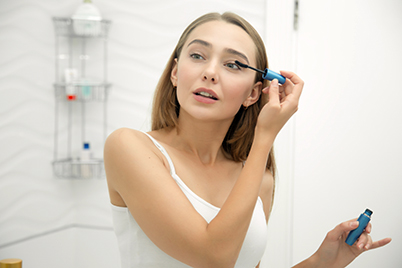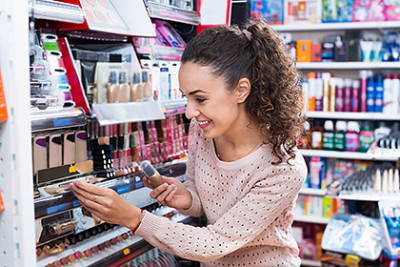I have acne! Is it okay to wear makeup?

How to figure out if makeup could be causing your acne
If you have acne cosmetica, you’ll likely have many tiny bumps on your face. These bumps usually appear on the cheeks, chin, or forehead. Many women develop whiteheads that rise above their skin slightly. You may also notice some pimples.
If you have tiny breakouts around your lips, your lipstick or lip balm could be the culprit.
Acne cosmetica can take time to appear. It can take anywhere from a few days to 6 months for blemishes to appear.
This delay can make it difficult to see a connection between acne and the makeup causing it. As you see new blemishes, you may treat the acne and then cover it with acne-causing makeup. Continuing to use the makeup leads to a never-ending cycle of breakouts.
This never-ending cycle can feel frustrating. Many women start to believe that nothing will clear their acne.
Makeup tips for acne-prone skin
Since acne-prone skin is sensitive, people with acne may find that certain makeup products, such as foundations and concealers, worsen acne or cause new breakouts.
However, dermatologists from the American Academy of Dermatology say it’s okay for acne patients to wear makeup. The key is to select cosmetics that don’t cause acne and establish a skin care routine that works for your skin type.
To wear makeup on acne-prone skin, follow these tips from board-certified dermatologists.
How to clear acne cosmetica
Even when makeup causes your acne, you can still wear makeup and see clearer skin. You’ll have to use different makeup though.
Here’s what dermatologists recommend to see clearer skin.
Choose your makeup carefully. You’ll want to immediately stop using all makeup that’s causing your breakouts. Of course, it can be hard to tell what’s causing your acne. The best strategy is to read all the labels on your makeup as well as skin and hair care products.
Check product labels
Make sure you see one of the following terms on your products: Oil-free, won’t clog pores, or non-comedogenic.

Wash your face twice a day with a mild cleanser, and after you finish any activity that makes you sweat. Dermatologists recommend that you wash your face when you wake up and before you go to bed. You want to use a cleanser that includes one of the following terms on its label: "Oil-free," "won't clog pores," or "non-comedogenic."
When cleansing your face, gently apply your cleanser with your fingertips and rinse it off with lukewarm water.Remove your makeup, including eye makeup, before going to bed. Use an oil-free makeup remover. After removing your makeup, wash your face with a gentle cleanser. Avoid scrubbing your face, even when removing makeup.
Apply makeup gently. Your touch should be feather light. You want to avoid irritating your skin. Makeup brushes can help you apply everything gently.
Clean your makeup brushes every week and make sure you’re the only one who uses them. While acne isn’t contagious, acne-causing bacteria, dead skin cells, and oil from other people’s skin can stick to your makeup, makeup brushes, and applicators. When you use shared makeup and tools, those acne-causing culprits can spread to your skin, leading to new breakouts.
Treat your acne. Acne cosmetica will often clear when you stop using the makeup and hair and skin care products that clog your pores.
If anything else is causing your acne, however, you’ll still see acne. That’s why dermatologists recommend that you treat your acne with products that contain one or more of the following ingredients:- Benzoyl peroxide (fights acne-causing bacteria)
- Salicylic acid (helps unclog pores)
- Adapalene (helps unclog pores)
It can take 4 to 8 weeks to see some improvement.
When to seek a dermatologist’s help
Acne cosmetica tends to clear once you stop using what’s causing it. But finding the cause can be difficult. So many products can lead to acne cosmetica, including foundation, blush, and concealer. Some hair and skin care products can also cause it.
To complicate matters, more than acne cosmetica could be causing your acne.
A dermatologist can help you sort it out, so you can see clearer skin.
Images
Getty Images
References
Baumann L. “Cosmetics and skin care in dermatology.” In: Wolff K, Goldsmith LA, et al. Fitzpatrick’s Dermatology in General Medicine (seventh edition). McGraw Hill Medical, New York, 2008:2360.
Fulton JE, Acne Rx: What acne really is and how to eliminate its devastating effects! Self-published; 2001.
Harper JC. “Acne: The basics.” Paper written by dermatologist Julie C. Harper, MD to help her patients get the best results from their acne treatment. May 2003.
Singh S, Mann BK, et al. “Acne cosmetica revisited: a case-control study shows a dose-dependent inverse association between overall cosmetic use and post-adolescent acne.” Dermatology. 2013;226(4):337-41.
 Atopic dermatitis: More FDA-approved treatments
Atopic dermatitis: More FDA-approved treatments
 Biosimilars: 14 FAQs
Biosimilars: 14 FAQs
 How to trim your nails
How to trim your nails
 Relieve uncontrollably itchy skin
Relieve uncontrollably itchy skin
 Fade dark spots
Fade dark spots
 Untreatable razor bumps or acne?
Untreatable razor bumps or acne?
 Tattoo removal
Tattoo removal
 Scar treatment
Scar treatment
 Free materials to help raise skin cancer awareness
Free materials to help raise skin cancer awareness
 Dermatologist-approved lesson plans, activities you can use
Dermatologist-approved lesson plans, activities you can use
 Find a Dermatologist
Find a Dermatologist
 What is a dermatologist?
What is a dermatologist?
